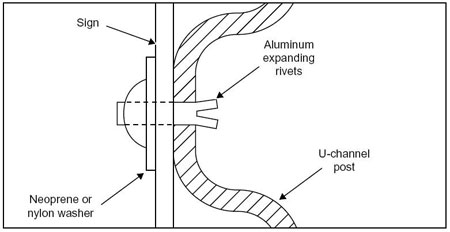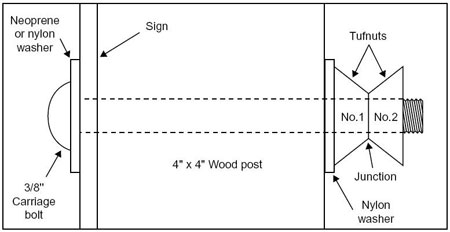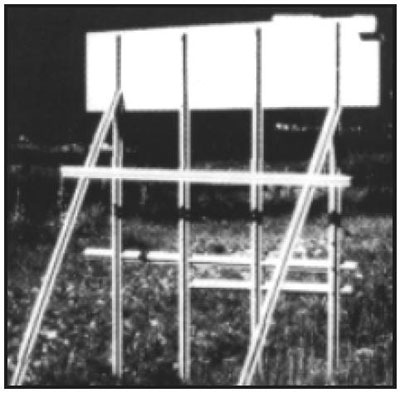The inspection process just discussed will identify sign and sign support deficiencies that will require appropriate repair or replacement. In addition, there are certain ‘preventive’ maintenance activities that may be needed to keep signs and their supports fully functional; these include:
- Sign cleaning.
- Vegetation control.
- Anti-theft measures.
- Sign support adjustments.
Sign Cleaning
Usually, it is not necessary to clean the sign face as periodic rain will help clean the sign. However, localized conditions, especially in urban areas, may cause the sign to become less visible due to the buildup of dirt, grime, mildew, or mold. Locations where sign cleaning may be warranted include:
- Signs under trees.
- Signs along routes with heavy truck traffic.
- Areas with infrequent rainfall.
- Signs in industrial areas.
Also, before deciding to replace a sign because of observed low night time visibility, the sign life might be extended simply with cleaning.

Signs under a tree canopy are often covered with mold (left photo) which can easily be cleaned (right photo, right half of sign).
When cleaning a sign a non-abrasive cleaner free of damaging solvents should be applied with a sponge or soft bristle brush. Pressure sprayers may be used if not sprayed so close to the sign that it would damage the sheeting face. Whatever procedure is followed, it is best to first check with the product supplier and test out any chemical cleaner on a sign in the maintenance yard before use in the field.
Vegetation Control
One of the common deficiencies found during an inspection is partial or full blockage of the sign by roadside vegetation. During the spring and summer seasons, fast growing weeds can quickly cover a sign as will tree branches and brush. If sign inspections are done during these seasons, these situations should be readily identified. And, if the technician has suitable equipment, it can be rectified during the inspection. The topic of vegetation control is more thoroughly discussed in the FHWA field guide entitled, Vegetation Control for Safety, A Guide for Local Highway and Street Maintenance Personnel.

The warning sign (circled) is only partially visible in the spring. By mid-summer, it will be completely hidden by vegetation.
Anti-theft Measures
Unfortunately, signs are occasionally stolen for any number of reasons. This can be avoided by making it difficult to remove a sign and by enacting laws to penalize vandals. Specific fasteners can be used to attach signs to support posts which make it far more difficult for vandals to remove sign panels. Among the more common special fasteners in use are:
- Expanding anchor bolts and blind aluminum rivets.
- Bolts (or nuts) that require special tools to install and remove them (such as fluted nuts or star bolts).
- Nuts with shear-off heads.
- Simply hammering down the excess portion of the threaded bolt so that it cannot be easily unscrewed.

Simple details of anti-theft /anti-vandal fasteners.

Expanding anchor and blind aluminum rivets.

Fluted nuts (double pyramid shape).

Shear off heads.

Bent over bolts.
Sign Supports
Preventive maintenance activities that deal with the entire sign to include the sign support, include:
- Ensuring the sign post is still firmly placed in the ground. During formal or informal inspections of signs, a sign leaning away from the vertical will likely indicate that the sign post is no longer stabilized in the ground or not properly attached to the slip base.

Visibility of sign will diminish if not vertically straight. - Maintaining the sign crashworthiness by not adding additional unnecessary supports and braces. The sign, pictured to the right, has multiple posts supporting it when two are probably enough. Also, two horizontal braces cross the bottom. These increase the strength of the support greatly, but a small car hitting this is likely to stop suddenly, causing severe damage. Larger posts with breakaway mechanisms at the ground would be the safe construction.

Too many posts and braces can be a safety hazard. - Positioning the sign so that it is not frequently hit or adding a marker to increase its visibility. Signs placed at the near end of a median island are frequently knocked down because of the tight radius for large vehicles to stay within the designated lane. Preventive measures include moving the sign back a few feet from the end and placing an object marker on the post, which increases the visibility of the sign structure.


Knockdowns of signs in the median may be avoided with use of an object marker. - The environment can also be a factor on the safety characteristics of sign supports. The two most common conditions that can affect the crashworthiness of a sign support are erosion of soil at the base and the growth of trees around the support.
